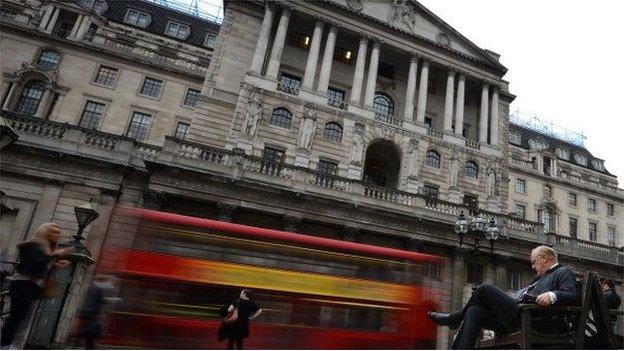RBS and Standard Chartered weakest in Bank stress test
- Published

Royal Bank of Scotland and Standard Chartered were the weakest of Britain's seven largest lenders in a Bank of England stress test.
For the second year, the central bank has subjected, external the UK's biggest lenders to tests to measure whether they would survive a financial shock.
This time, it was assumed that oil had fallen to $38 a barrel and that the global economy had slumped.
No bank was ordered to come up with a new capital plan.
Out of the seven banks tested, RBS and Standard Chartered were found not to have enough capital strength, but both took steps to raise capital, so were not told to come up with a new plan, as Co-Operative Bank was last year.
'Resilience'
Commenting on the results, RBS chief financial officer Ewen Stevenson said: "We are pleased with the progress we have made relative to the 2014 stress test, but recognise we still have much to do to restore RBS to be a strong and resilient bank for our customers."
Standard Chartered's chief executive Bill Winters said: "The results of the test demonstrate our resilience to a marked slowdown across the key markets in which we operate.
"The test was conducted on our balance sheet as at the end of 2014. Since then we have made further significant progress in strengthening our capital position.
"We are operating at capital levels above current minimum regulatory requirements and have a number of additional levers at our disposal to further manage capital."
Stress test results 'encouraging'
New measures
However, all banks were told they would have to set aside capital to protect their UK exposures as part of a new measure that the bank is phasing in, called a "countercyclical capital buffer".
The extra cash should allow banks more room in times of economic decline to absorb losses from bad loans and other problems.
It will mean the banks have to allocate more money to protect against lending losses in the UK, but some of this will be brought in from other reserves that the banks already have.
The regulator will advise banks when to fill the buffer, setting aside reserves during stable times in the economic cycle.
'We will not increase capital'
When trouble is expected, the regulator can set the buffer back to zero, freeing up reserves for banks to write down the value of loans they have made and accept losses if they need to.
"We will not increase capital... the overall level of capital won't increase in the system," said Bank of England Governor Mark Carney at a news conference. Large capital raisings are off the agenda and banks largely have or have access to the reserves they need, he said.
Still, the countercyclical capital needed will represent £10bn across UK banking, and banks will have to make profits or sell bonds or shares to fill some of that buffer.
And Mr Carney admitted that at its 1% peak, the buffer would could cost about 0.1% of gross domestic product after three years. Restraining credit growth is not what this new capital is for, Mr Carney said, but he warned that the extra capital costs will be passed on to customers. That probably means marginally higher rates for borrowers.

Analysis: Kamal Ahmed, BBC business editor
Today, the Bank of England has produced two reports dealing with the issue of financial stability.
Its key message? That the UK's major banks are in a relatively resilient state and that the need for ever higher regulatory controls is coming to an end.
Yes, the Royal Bank of Scotland and Standard Chartered had to do some work to strengthen their position.
But no-one failed the stress test.
This is an "inflection point" in the post-financial world - a new chapter, the Bank signalled.
The Bank does not believe in a "long march to ever more capital".
And feels that banks are now handling risk more prudently.

As well as economic stresses, new costs of £40bn were assumed to pay for potential misconduct.
UK lenders have spent billions of pounds repaying customers who were wrongly sold insurance or loans they didn't want, need or understand.
Regulators across the world have been imposing stricter rules on banks in order to try to avoid the publicly-funded bailouts needed following the 2008 financial crisis. RBS and Lloyds needed a combined £65bn in taxpayer money to keep them afloat.
Stricter next year
But holding more capital, for which investors demand a premium because of the risk, makes banking less profitable.
The Bank has tested seven lenders: HSBC, RBS, Lloyds, Barclays, Santander UK, Standard Chartered and Nationwide Building Society.
Last year, the list was eight long and included Co-Operative Bank. However, the Bank has said since that it will limit the tests to lenders with £50bn or more in deposits.
According to Bernstein analyst Chirantan Barua, next year's stress test will be much stricter, with a much higher capital bar. On that basis, it could be Barclays that looks closest to the bottom, according to his analysis.
Mr Barua says that out of the five biggest banks - RBS, Lloyds, HSBC, Barclays and Standard Chartered - all but Lloyds had a more difficult time this year, because of the more international focus of this year's tests.
- Published1 December 2015